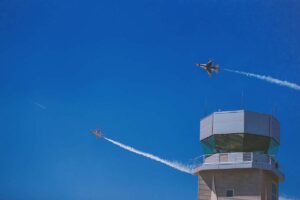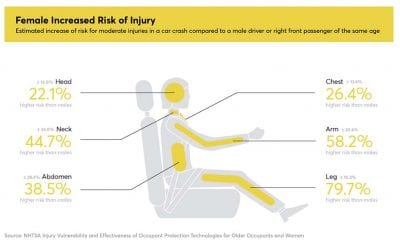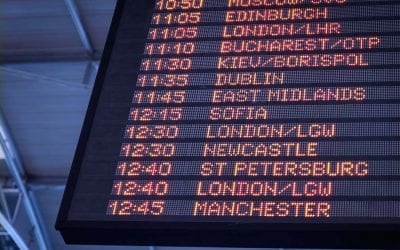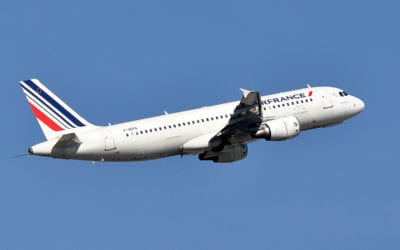Needed thoughts as advocates kick off the coming 2023 FAA funding bill.

Orlando Melbourne International Airport by Aral Tasher
Every aviation consumer should know how important this FAA funding bill will be. This is the major bill that will control spending for funding the air traffic organization and the explosive growth of unmanned aerial operations. Integrating the current air traffic control (ATC) with the new NASA-developed unmanned traffic control (UTM) systems will be a significant focus of the coming 2023 legislation.
This 2023 FAA funding bill will also create or eliminate consumer protections in our aviation network. Over the past 12 years, this FAA funding bill has taken on many consumer issues. The increase and control of ancillary fees and full-fare advertising regulations were debated. Increases in denied boarding compensation, lost/damaged/delayed checked baggage compensation, the creation of the consumer ombudsman, and the renewal of the Advisory Committee for Aviation Consumer Protection came from this bill. The family seating law (that DOT has ignored) and the FAA seat-size minimum testing were passed as part of this giant bill.
All affect the everyday rights of passengers.
The discussions are expansive, and Travelers United personnel have talked and listened to many current and retired staff members.

The 2023 FAA Funding Bill discussions were far-reaching and inconclusive, for the most part because of political changes.
Unless something changes dramatically in the next three months (unlikely in either the Senate or House), a push to reorganize the air traffic control (ATC) operations will not happen. The past FAA funding debates focused on changing the funding structure. The organization of the ATC operations will not be debated again. Several issues will be revived; however, during our conversations, there is no appetite for a political tête-à-tête over ATC’s operations.
Involve consumer advocates, airlines, airports, cybersecurity corporations, and other stakeholders in discussions.

Flying Car Vision
The massive infrastructure bill passed last year will probably affect the expansion of the airport and FAA tower rebuilding. Another issue set in stone is the makeup of the House and Senate committees. Both sides of Congress will change in 2022 before the finalization of the bill. This may mean new political debates during the elections. However, many of the basics of the coming 2023 FAA Funding Bill will take shape before the 2022 elections.
Other stakeholders like Homeland Security, TSA, and the FBI, will zero in on aviation security. There will be a new division of security operations between these organizations. Plus, the bill will deal with the maturation of space operations and the increase in unmanned aerial low-level flying. The US Space Force, the FAA, and NASA will find responsibilities divided in new ways. Plus, all federal departments must develop a harmonized structure that will overlay control of the national air space (NAS).
US airspace faces dramatic change in the next seven or so years.
- The current ATC operates for commercial and private flights that rarely exceed 100,000 aircraft. Yes, today, it is the safest and the largest program in the world, but it cannot grow exponentially. Integrating the current ATC system with space-level flights and low-level UAS operations will take careful planning, testing, and ingenuity.
- There will be a rapid deployment of space vehicles, satellite protection programs, and space-based repair facilities. The coming aviation reality will mean planning manned colonies on the moon and on Mars and a coming space cargo system that moves goods through space from point to point on Earth. These considerations, together with the development of spaceports, will force discussions never prevalent at the federal level.
- Urban air mobility will grow. UAS flights will begin to fill the air below about 500-foot altitude. The UAS systems will have to be autonomous. NASA has been working diligently on a UTC or unmanned traffic control system. The world’s aviation industry is working on developing programs that allow UASs to avoid telephone lines and to keep a distance from buildings as they zip through cityscapes. These drones or flying cars or air taxis must also avoid each other. Plus, they must not interfere with the current commercial aviation operations, integrate with space launches, and move goods and services through cities and across various landscapes.
- Every sector of the world’s airspace will need trained operators. That means training programs for the current commercial pilots, space astronauts, and earth-based UAV operators. The aviation infrastructure needs international standards and national rules and regulations.
All this will take a steady stream of funds.
The computer systems for such air space are massive, expensive, and unprecedented. This is only the beginning.
A new focus will be cybersecurity to keep computer operations working. Currently, problems with the hacking of IT systems are growing. Realistically, we must deal with the complexities of the needed systems and the ramifications of IT interference. A computerized system of this size and multiplicity has never been deployed. However, it will exist shortly. Security and continuous operation will be key.
Discussions and debates about the coming FAA bill are starting now. We have a long way to go.

Airport tower photo by Aral Tasher on Unsplash
READ ALSO:
How the FAA will integrate rockets, drones, and flying cars into our sky
Extra travel fees are out of control in post-pandemic travel.

Charlie Leocha is the President of Travelers United. He has been working in Washington, DC, for the past 14 years with Congress, the Department of Transportation, and industry stakeholders on travel issues. He was the first consumer representative to the Advisory Committee for Aviation Consumer Protections appointed by the Secretary of Transportation from 2012 through 2018.



